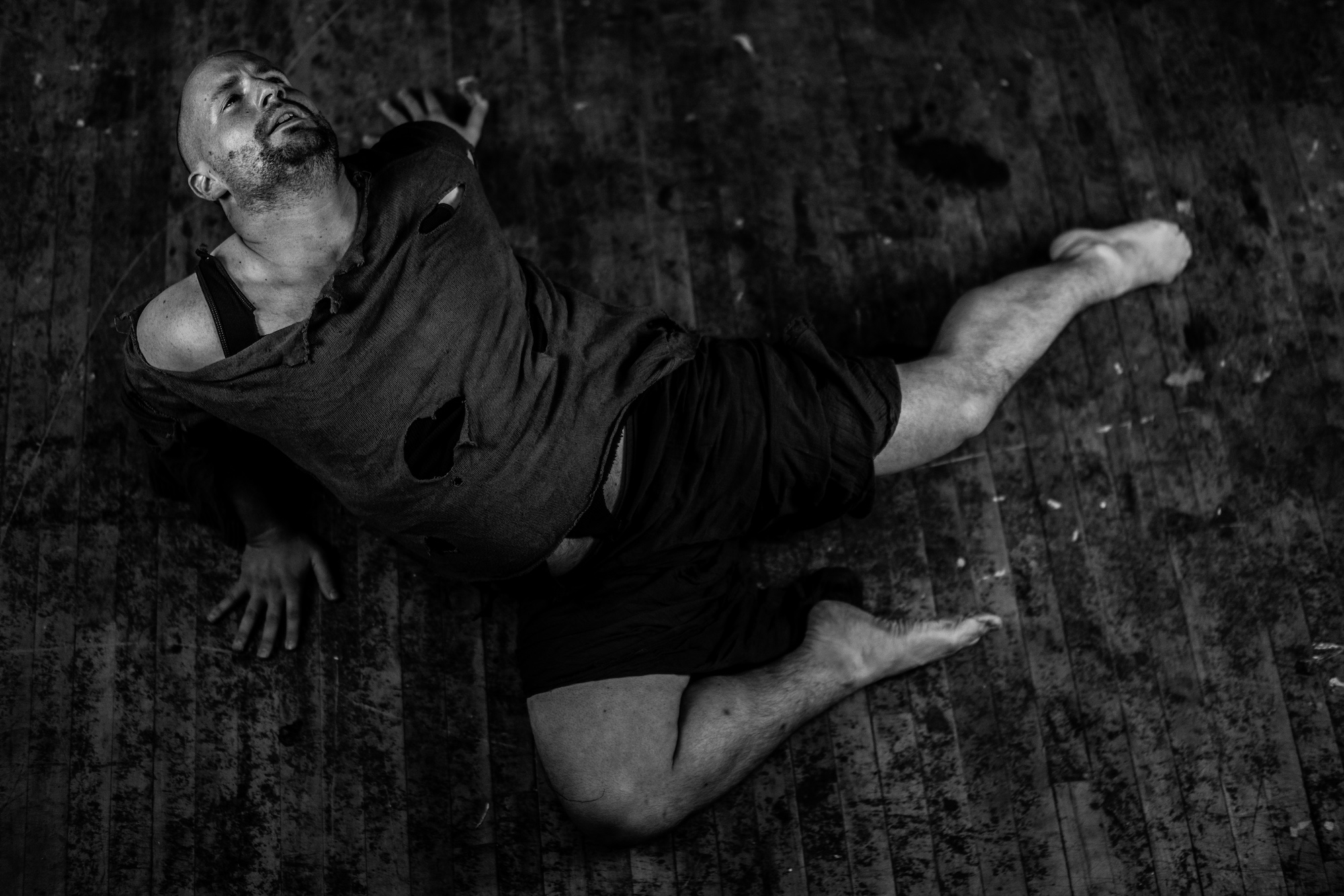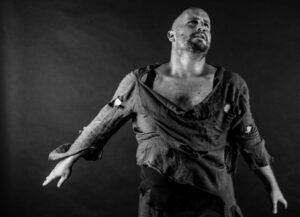
Photo by Robbie Sweeny
[ID: In black and white: Zackary Forcum, a nonbinary performer, lays on a wooden floor, their bare legs are splayed to the left (bent at the knee), their arms push their torso away from the floor. The performer has a light complexion, is bald and wears tattered/ripped dark clothing. Their expression is contemplative.]
It was Agent Betty that I saw first. I was traveling home on BART, listening to some 1980’s rock music when they stepped into my mind and stood in front of a well-armed police station. Cops surrounded the lone fighter but within seconds of engaging one another, Betty bested all of them in hand-to-hand combat.
“Why is Betty here?” I thought.
Silence for a moment and then.. “They are orchestrating a jailbreak” a voice answered.
“Ok… so why orchestrate a jailbreak at all?”
More momentary silence. “Perhaps… The people being held inside are innocent of the crime they are being accused of. Perhaps if they aren’t rescued, terrible things will happen to them.”
“So… what is the crime?”
“It would have to be BIG.”
Another voice, one with a flair for the dramatic, answered, “The Great Commander… Is DEAD!”
It actually wasn’t that moment that I knew I had something. Just spare thoughts singing to me, helping me wander through the monotony that accompanies public transit.
But as often the case in circumstances like this… This scene replayed in my mind over and over, often as I walked the dog or picked up morning coffee or rushed away to work. So… I keep asking questions. Questions seemed to help calm my mind, to help me think on other things.
“Who is the Commander and why is he dead? NO.. why was he murdered?”
“Who was the murderer?”
“Who are the suspects?” “Why are they the suspects?”
And so, the story began to develop of a world, which on the surface was filled with good gods and evil devils, but when considered closer, we find out that everyone is a villain.
***
I felt like I was done with the Bay Area’s dance scene. I had learned from an early age that when love is no longer being served, it’s time to go. As we reemerged from the pandemic, with so many friends and leaders who had left the region (and so many of the ones who remained struggling to simply function in this wild world), and experiencing so much finger pointing and infighting within the community, you could say I was disillusioned. That the veneer that surrounded our field, one I once wanted to embrace and be a part of, had not only lost its shine and allure but also, any practical use.
Before the pandemic fatally struck and collapsed so much of our industry, I also knew it was time for a change. I had been creating and performing new dance theater works as a solo artist under my company OOMPH Dance Theater, and while I was getting constructive attention, I knew it was time to think bigger. I didn’t necessarily know what that meant at the time, and all the while the pandemic held us all hostage (along with losing all career-momentum that I built up), I still didn’t discover what that meant.
I also had spent so much time from 2017-2019 creating work around the intricacies of trauma and examining it onstage, but a shift had occurred within me. I had realized that I held onto anger as a means of survival and an attempt at controlling the last bits that remained in the wake of all that had been taken from me from bigots and abusers. That the tactics that had saved me for so much of my life had started to become a detriment. I began to wonder… if I keep holding onto all of this anger to maintain the remaining fragments of what was lost… is there room for anything else? What else could there be space for—where else might I go? What would happen if I consented to something I had always put out of reach?
As it got safer to be in the world once more, and not necessarily knowing how to step forward, I told myself it was time to try new things. So I joined a rugby team and god I was terrible (I got better, but boy-howdy, I was magnificently bad in the beginning). I also consented to work with a close friend on a movement-poetry performance piece focusing on “softness” (an always worthy pursuit). And of course, Agent Betty and the constantly evolving story that silently traveled with me wherever I went was only satisfied if I actively kept dreaming it—developing it—giving form to what was speaking to me.
It seemed to me that the best way to tell the story was by writing a dance theater play. Not necessarily a musical, but a narrative and text-based production that utilized dance (outlined as choreographic scores within the work). I came to call the piece, “Villains.” I sat down and outlined the production to provide a structure to work from—it would be a play in two acts. The first act would function as a “who done it” murder mystery, introducing all major characters and setting the stage for act two, which would showcase all parties banding together to defeat a “big bad” enemy. All movement would be based in a sense of magical realism, and would be utilized to not only further the plot and tell the story, but also to showcase the extraordinary abilities of the super-villains themselves. Dance to me has always been somewhat magical and mysterious, so why not have these characters’ otherworldly powers be experienced through the medium? A voice told me to think big and unencumbered and as I began writing I knew I needed to build a world in which to properly tell the story—that the setting itself was its own character, and that in addition to the piece’s leading figures I would need a Greek-like chorus, an ensemble that would shapeshift repeatedly to tell the stories of the people living within a troubled city.
***
When I create, I often think of playwright Suzan-Lori Parks who once shared, “Why do I write? Sometimes I feel like I’m a haunted house. And writing helps me deal with the spirits that reside in the house.” Our culture places so much importance on the sole “leaders,” the CEO geniuses of the world who have such great ideas that often do not come from them at all. I don’t really function like that, but like Parks, and many great companies in the Bay Area that value collective leadership, I feel like a vessel.
The only time I feel like I am at a loss or am fighting my creative process is when I do not write/dance. Because when I sit down and hold space for the voices that want to speak, they flow out of me. And it is these moments where I feel most powerful and alive. So logical are their responses, shaping their form with characters, situations, lives that have been lived in and have a depth of meaning/experience.
Of course it is not only inspiration that shapes my work, but also my years working in the craft. I often think of Jim Berman from UC Santa Cruz who encouraged his playwriting students that everytime a character spoke there was a reason for it and that realism on stage was never 100% real, that it was either 90% or 110%–we are manufacturing the moment being witnessed onstage, and that because of this, we can make these moments progress better than they are experienced in everyday reality. The influence of my great dance mentor Jacqueline Burgess is always with me–who encouraged me to utilize movement in the process of abstraction, to tell deeper narratives through dance when words are inadequate/take too long/fail all together.
The results that have come through in this process have been… surprising.
***
In this process, I’ve often cried when I write. The voices and scenes that flash through my mind do not demand much, but space to be heard and I find the stories they tell a bit heartbreaking at moments. As I began to finish the work at the end of summer 2023 my father became deadly ill. As I helped him recover throughout the fall, I needed to save my tears for a different kind of work with him (much to the voices’ discontent). At the time of writing this article I have three scenes left to complete…
I look forward to welcoming the Bay Area’s dance community into a staged reading of “Villains” in spring 2024. I find… people love villains. Not only since they are often fabulous and unapologetically outwardly-delight in their lives and purpose (which is a joy to witness), but because at the end of the day, we are all painted as the villain at some point (or many points) in our lives. That it is in the villain, not the hero, that we truly see ourselves. That the internal conflict which so many struggle with is central to our humanity. As so many know but easily forget when push-comes-to-shove, the complexity of the world cannot be affixed to the binary of black and white, good or evil, right and wrong–that sometimes… the wrong is right, the bad guy is good, and that when we label someone as the villain, we become one too. I look forward to sharing this work with you. Until then, please be kind with yourselves and with others. And give the voices space to speak.

[ID: In black and white: Zackary Forcum, a nonbinary performer, stands in front of a grey background, their arms held at an angle to their side. The performer has a light complexion, is bald and wears tattered/ripped dark clothing. They look up/into the distance.]
This article appears in the Winter 2024 issue of In Dance.


